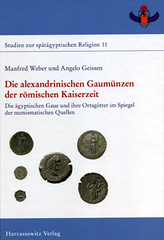
PREV ARTICLE
NEXT ARTICLE
FULL ISSUE
PREV FULL ISSUE
NEW BOOK: THE COINS OF THE ALEXANDRINIAN NOMES
Ursula Kampman published a review of a new German-language book in the August 29, 2013 issue of CoinsWeekly. Here's an excerpt. See the complete review online for more information and how to order.
-Editor
It is impressive how much Manfred Weber and Angelo Geissen present to their readers en passant. Of course this book is a complete type catalogue. But the information regarding the interpretation of the coin designs startles even excellent experts of the Roman Empire demonstrating how profoundly the Roman administration in Egypt became acquainted with the local customs. Nome coins were issued only under very few emperors and only on particular occasions. With sound reasons the authors suggest to link these coin series with the decennial anniversary of enthronement seizing thus on an ancient Egyptian feast. As far back as in the times of the pharaohs the whole country represented by the nomes rendered homage to the pharaoh on occasion of the festival of Sed. Antoninus Pius appears to have referred to this traditional ceremony when celebrating the wedding of Marcus Aurelius and Faustina. Certainly that was the reason why nome coins were issued during his reign. The authors explain what exactly was shown on the nome coins portraying one nome after the other. First they give a short general introduction into the nome presenting the nome symbol, the most important towns, its location and historical-economical relevance. Then follows a much longer part dealing with the local cults. After this the reader finds a catalogue of all those coin types which name this nome. In the section ‘Ergebnis’ (‘result’) an interpretation of the images on the coins is given. The photos of the coins are collected on thirty plates. Manfred Weber, Angelo Geissen, Die alexandrinischen Gaumünzen der römischen Kaiserzeit. Die ägyptischen Gaue und ihre Ortsgötter im Spiegel der numismatischen Quellen. XIV + 406 p. 123 images on 30 pl. 29.7 x 21 cm. Hardcover. Harrassowitz Verlag, Wiesbaden, 2013. ISBN 978-3-447-06846-8. 124 euros (D), 127.50 euros (A), 167 CHF. To read the complete article, see: The coins of the Alexandrinian nomes (www.coinsweekly.com/en/News/4?&id=2237)

Wayne Homren, Editor The Numismatic Bibliomania Society is a non-profit organization promoting numismatic literature. See our web site at coinbooks.org. To submit items for publication in The E-Sylum, write to the Editor at this address: whomren@gmail.com To subscribe go to: https://my.binhost.com/lists/listinfo/esylum All Rights Reserved. NBS Home Page Contact the NBS webmaster 
|
